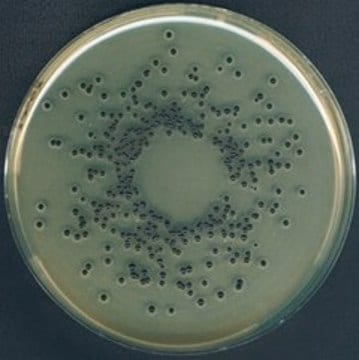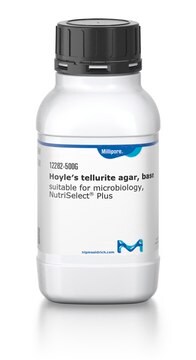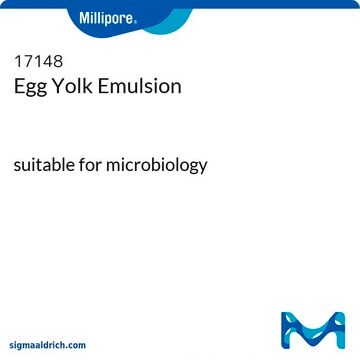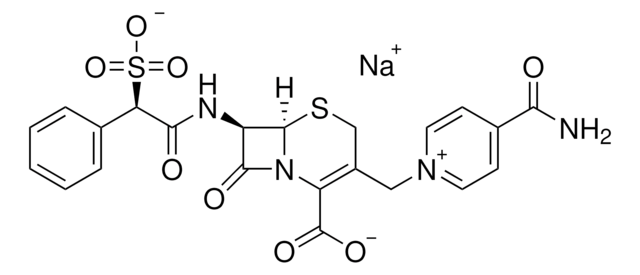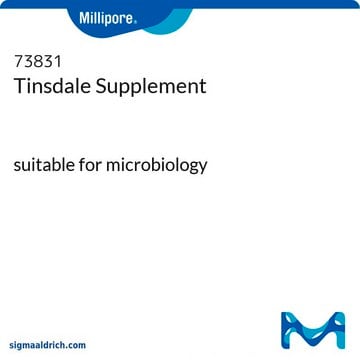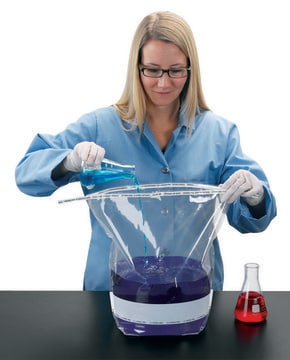17774
Potassium tellurite solution
1% in H2O, suitable for microbiology
Sign Into View Organizational & Contract Pricing
All Photos(1)
About This Item
CAS Number:
MDL number:
UNSPSC Code:
41171614
PubChem Substance ID:
NACRES:
NA.85
Recommended Products
Agency
according to ISO 6888-1:2020
Quality Level
sterility
sterile (Filtered and Aseptic Handled)
form
liquid
shelf life
limited shelf life, expiry date on the label
concentration
1% in H2O
application(s)
environmental
food and beverages
microbiology
storage temp.
2-8°C
suitability
Corynebacterium spp.
Staphylococcus spp.
SMILES string
[K+].[K+].[O-][Te]([O-])=O
InChI
1S/2K.H2O3Te/c;;1-4(2)3/h;;(H2,1,2,3)/q2*+1;/p-2
InChI key
BFPJYWDBBLZXOM-UHFFFAOYSA-L
Looking for similar products? Visit Product Comparison Guide
Application
A filter sterilized solution of potassium tellurite for the selective isolation of Staphylococci and Corynebacteria.
Other Notes
10 mls per vial
sterile 1% Potassium tellurite Solution in water
Storage Class Code
10 - Combustible liquids
WGK
WGK 2
Flash Point(F)
Not applicable
Flash Point(C)
Not applicable
Personal Protective Equipment
dust mask type N95 (US), Eyeshields, Gloves
Choose from one of the most recent versions:
Already Own This Product?
Find documentation for the products that you have recently purchased in the Document Library.
Customers Also Viewed
Miguel E Castro et al.
Biochemical and biophysical research communications, 380(1), 148-152 (2009-01-27)
Potassium tellurite (K(2)TeO(3)) is harmful to most organisms and specific mechanisms explaining its toxicity are not well known to date. We previously reported that the lpdA gene product of the tellurite-resistant environmental isolate Aeromonas caviae ST is involved in the
Miguel E Castro et al.
Biochemical and biophysical research communications, 375(1), 91-94 (2008-08-05)
Potassium tellurite (K(2)TeO(3)) is extremely toxic for most forms of life and only a limited number of organisms are naturally resistant to the toxic effects of this compound. Crude extracts prepared from the environmental isolate Aeromonas caviae ST catalize the
Lillian G Acuña et al.
Archives of microbiology, 191(5), 473-476 (2009-03-31)
Potassium tellurite is highly toxic to most forms of life and specific bacterial tellurite defense mechanisms are not fully understood to date. Recent evidence suggests that tellurite would exert its toxic effects, at least in part, through the generation of
C C Vásquez et al.
Current microbiology, 43(6), 418-423 (2001-10-31)
The nucleotide sequence of a 4,539 bp fragment of Bacillus stearothermophilus V mediating tellurite resistance in Escherichia coli was determined. Four ORFs of more than 150 amino acids encoding polypeptides of 244, 258, 308, and 421 residues were found in
Xing-Long Xiao et al.
The Journal of general and applied microbiology, 56(6), 465-474 (2011-02-02)
A selective enrichment broth (SVV) was formulated to allow concurrent growth of Salmonella spp., V. parahaemolyticus, and V. cholerae. Potassium tellurite and sodium citrate were added as the inhibitors, while glucose, mannitol, anhydrous sodium sulfite and sodium pyruvate were employed
Our team of scientists has experience in all areas of research including Life Science, Material Science, Chemical Synthesis, Chromatography, Analytical and many others.
Contact Technical Service

